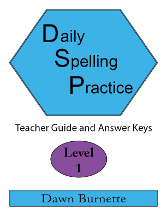Daily Spelling Practice is a phonetic approach to spelling, but it also includes sight words and words with unusual spellings. Each week focuses primarily on a group of words that share a common phonogram, but it also addresses other patterns and rules for spelling. Daily Spelling Practice avoids the spelling list approach where students memorize a set list of words each week. Instead, it aims at developing skills that that help students spell the majority of words, even those with which they are not familiar.
Starting with short-vowel words at the beginning of the first level, lessons progressively teach different, more-challenging phonograms as you move from Level 1 through Level 4. Books are ideal for grades two through six, but they are not restricted to those grade levels. Students who know the sounds of the letters and are able to read might be ready for Level 1. If you don’t have four years to complete the series, you might want to use the Daily Spelling Practice One-year Intensive. It condenses the lessons to cover the key elements of the complete, four-year course within a year. It should be especially helpful for older students.
The Teacher Guide and Answer Keys book for each level is essential. The student workbook for each level is optional if you are willing to write out each day’s activities for students. However, I think the inexpensive workbooks are a sensible investment for the amount of time they save. (There are also overhead transparencies that would save you both workbooks and writing things out, but they really only make sense for a group class.)
All four levels follow the same lesson sequence each week with daily lessons. Each week’s lesson is contained on a single page. Each week begins with the introduction of the week’s key word, found at the top of the week’s lesson with the phonogram to be taught underlined. The author identifies these key words as “keys.” Student workbooks have a series of from three to five “target words” to complete with only the key phonogram preprinted in their workbooks; the teacher dictates the target words which students are to complete. For example, for the phonogram “ai,” students complete the words to write main and chain. The teacher then helps students check and correct the spelling of those words. Next are a few blank lines for students to write their own choice of words that contain the key phonogram. The teacher will need to check these. The last part of Monday’s lesson is the introduction of one sight word which students write three times.
Tuesday’s lesson teaches “Adding on,” which might be adding a prefix or suffix, creating a compound word, or working with word roots. Often, a rule accompanies this exercise. Sometimes, the exercise requires dictation by the teacher.
On Wednesday, students study “confusables”—words and spellings that are easily confused. Sometimes these relate to the key word. For example, in the aforementioned lesson on “ai” the confusables are the words sail and sale. Sometimes confusables relate to the “Adding on” activity. Students will also write their own complete sentences using the confusable words.
Thursday’s lesson lists five pairs of words, directing students to underline the word in each pair that is spelled correctly. These words might be from previous lessons, or they might reflect the key or "Adding on" rule for that lesson, but they will not repeat the target or "Adding on" words themselves. (The goal is to teach students to identify and apply patterns and rules rather than memorize a set list of words.) After that, they peruse the lesson page to find and circle all words that contain that week’s key phonogram. Remember that the entire week’s lesson is on this page, so students are searching through instructions, rules, and sample sentences.
Friday is for assessment, but the author cautions against treating this like a spelling test. The teacher dictates the week’s key word, the target words, “adding on” words, memory word, and confusables. The teacher pulls these from each day’s lessons rather than from a “test” list. The author suggests including different words that reflect the rules or patterns to assess whether or not students grasped the concepts since that is the real goal.
Cumulative reviews follow every fifth week’s lesson. A Pretest/Posttest is included in each book.
The One-year Intensive has a different layout. Each day has its own lesson, and daily lessons are not connected to one another other than that there is a progressive sequence. There are three days’ lessons per page. Concepts are condensed. For example, the phonograms “oa” and “ow” that both make the long “o” sound are taught together on one day rather than in separate weeks.
Daily lessons, whether in Levels 1 through 4 or One-year intensive, should not take more than 10 to 15 minutes to complete, but they do require teacher involvement much of the time. Young students might need a little more time than older students. No lesson preparation is needed. Teacher guides have answers overprinted on student pages, so it is easy to quickly check student answers when they are predictable.
Daily Spelling Practice makes sense in theory. However, I think results might depend very much on each student’s ability to generalize from the relatively small numbers of words they practice for each phonogram as well as their ability to recall the “Adding on” and “confusable” rules they learn. On the other hand, I think learning spelling words based on common phonetic elements or structures works very well for many students. Additionally, Daily Spelling Practice does require more creativity than most spelling programs as students need to come up with their own words on Mondays and their own sentences on Wednesdays, another feature that will appeal to some students and not others. Overall, I expect that many students will like the variety in Daily Spelling Practice, and many will prefer the critical thinking activities over the memorization approach of most traditional programs.








